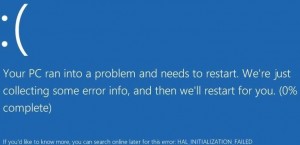 I’ve been struggling a lot lately with my Windows 10 laptop. Admittedly, this beast was upgraded to Windows 10 from an earlier preview version, rather than a fresh clean install. But it’s been updating automatically ever since. So Microsoft ought to have been able to progressively fix the issues, right?
I’ve been struggling a lot lately with my Windows 10 laptop. Admittedly, this beast was upgraded to Windows 10 from an earlier preview version, rather than a fresh clean install. But it’s been updating automatically ever since. So Microsoft ought to have been able to progressively fix the issues, right?
Alas, no. Time and again, the machine restarts for no apparent reason – certainly not high-stress usage – and I’m confronted with the Windows problem screen a.k.a. the Blue Screen of Death (see above). Sometimes it doesn’t start up properly at all. Sometimes it does start, but the WiFi won’t register unless the wireless adapter is disabled, then re-enabled. All this is very vexing, and happens one way or another at least one time a day, and usually several.
Yet, when I compare my many Android devices, they’re a breeze in comparison. I can’t even remember the last time I had to restart my Amazon $50 Kindle Fire 7-inch and favorite ereader, or my Lenovo A7-10 tablet, or my Vodafone Smart 6 Grand, for technical reasons. They run their programs smoothly and without apparent complaint. If there ever is a program crash – and I can’t even remember clearly when I last had one, they’re so rare – it’s simplicity itself to just restart the program with an icon tap. I haven’t lost any work I can remember recently while working in an Android system. It happens fairly often in Windows.
I can also remember a time when I struggled with Android phones and mobile devices. Also, no longer. And remember, these are always-on devices, exposed to OS stress, hacks, viruses, etc. 24/7. Yet they Just Work.
I’m afraid that long periods of complacency at Microsoft has left its OS engineers far more indulgent towards errors and failures than they ought to be. Furthermore, Windows 10 is now supposed to be practically a mobile OS in itself. I think Microsoft has a lot of work to do now that mobile OSs are almost as versatile and functional as Windows. And I think we deserve that. After all, if Android can do it across its multitude of form factors and interations (several of them running concurrently in my home), can’t Windows?
































I’ve upgraded about 35 laptops, desktops and windows tablets to Windows 10 and have seen the blue screen of death on only one occasion. Returning it to windows 7 was very, very easy, (if done within 30 days) and I recommend you do the same. In my case, I suspect some issues with the way data was moving in and out of RAM. I also found a Dell 6400 that would not upgrade because the processor did not meet the appropriate configuration for Windows 10, but for everything else, the transition and usage has been flawless.
I’ve always worked on the theory that one should not use a new Windows version until the first service pack comes out. Evidently, Microsoft has decided “no more service packs”, so I think I’ll just stick with Win8+Classic Shell until this computer dies.
Upgrading from windows 8 or 7 is no problem, upgrading from a windows 10 preview? That’s just asking for trouble. If MS failed to update the version number of a preview version component when going to the release version, the upgrade wouldn’t replace it and you now probably have a mix of preview and release content. Reinstall time.
Still on Windows 7 64 bit. No problems here 😉